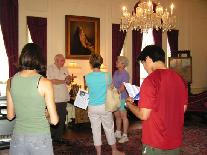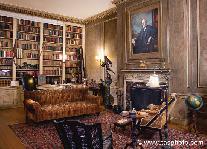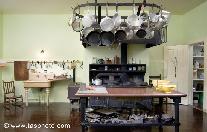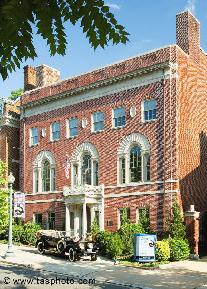AMERICAS
Woodrow Wilson House (U.S.)
(Aug. 17, 2009)
by John Powell, Curator
Woodrow Wilson House was the final home of Woodrow Wilson (1856-1924), the 28th President of the United States, who founded the League of Nations and shaped the modern U.S. Presidency. Today, Woodrow Wilson House is a National Historic Landmark and presidential museum that focuses on President Wilson’s “Washington Years” and promotes a greater awareness of Wilson’s public life and ideals through guided tours, exhibitions and educational programs. A National Trust historic site, the museum also serves as a community resource and preservation model dedicated to the stewardship and presentation of an authentic collection and property.
Wilson’s primary goal at the outset of the European war in 1914 was to maintain American neutrality and help to negotiate peace between the warring parties. During his second presidential campaign, Wilson promised the American people that he would work to keep the U.S. out of the war in Europe. He tried to keep this promise, focusing instead on domestic issues and social reform. However, after several attempts to broker peace failed, and American ships in neutral waters were fired upon and sunk, Wilson called upon Congress to declare war in 1917.
Soon after the first American troops saw their first combat, Wilson issued his Fourteen Points for Peace, such as “Open covenants of peace” and “Absolute freedom of navigation upon the seas,” in January 1918. By November of that same year the terms of an Armistice had been drawn up and hostilities ceased. In achieving victory, Wilson met
his chief war goal: peace.
At the conclusion of the war, the nations of the world gathered in Paris to discuss peace. Wilson moved the seat of the presidency to Paris for the six months of the peace conference. There he commanded the attention of the world, drawing up terms of peace and laying out his design for a League of Nations, a world body to settle future conflicts among nations, which was the cornerstone of his Fourteen Points.
However, Wilson’s biggest fight was yet to come. Back in the United States, the Senate was ready to assert its authority over the implementation of any treaty. The Senate had its reservations over the League, reservations that still echo today about the U.S. losing sovereignty and becoming the “policeman of the globe.” The Senate failed to ratify the treaty, despite two attempts and a cross-country trip by the president to bring his message
directly before the American people. It was during this trip that Wilson suffered the devastating stroke that left him politically and physically disabled.
After a hiatus in the awarding of the Nobel Peace Prize during the First World War, nominations were called for in 1920. Letters of support for Woodrow Wilson poured in from nominating committees all over the world for the award to be given to the founder of the League of Nations. In December 1920, Woodrow Wilson was awarded the Nobel
Peace Prize for the year 1919.
On March 4, 1921, Woodrow Wilson motored to his new residence in the Kalorama section of Washington, D.C. To his surprise, several hundred people were waiting to watch him enter the house where he would spend the last three years of his life. Each year, thousands still visit the final home of the 28th U.S. President. The house remains for us today as it was when he lived here, a place for insightful reflection on his career as educator, social reformer, peacekeeper, and world statesman.
The remarkable collection offers the visitor unique insights into the personality of one of America’s greatest leaders. On display are objects from the White House, family items, memorabilia, and elaborate gifts of state from around the world. The house is also a living textbook of “modern” American life in the 1920s--from sound recordings to silent films, flapper dresses, and zinc sinks.
Woodrow Wilson House strives to be the preeminent historic site dedicated to educating audiences about President Wilson’s legacy, including his ideas on peace, through a range of programs, activities, and events for all audiences. To learn more, please visit our website where you can explore educational materials and an interactive timeline of Wilson’s life, as well as information on upcoming events, current programs and exhibitions.
Address: 2340 S St., NW, Washington, DC, 20008, USA
Phone: +1-202-387-4062
Homepage: www.WoodrowWilsonHouse.org
Days closed: Monday, Major holidays
Admission: Adults: $7.50; Seniors: $6.50; Students $3.00; under age 7: free; Friends of the Wilson House & National Trust members free. Group rates available.
(Originally published on August 3, 2009)
 Peace Museums of the AMERICAS
Peace Museums of the AMERICAS



